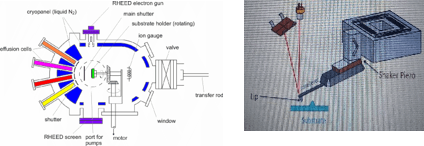Developing SiGe on Sapphire Technology
Student: Emmanuel Wangila
Degree: Ph.D, August 2022
Major Professor: Dr. Fisher Yu and Dr. Greg Salamo
Research Area(s):
Microelectronic-Photonic Materials & Devices
Background/Relevance
-
Using sapphire substrate will reduce the parasitic capacitance hence better frequency response and less power loss.
-
Incorporating Sn on Ge and SiGe induces direct band gap which helps in fabricating photodetectors that are more sensitive to infra-red due to radiative recombination.
Innovation
-
Growing SiGeSn and GeSn material on sapphire that can be used to make photodetector of its kind.
-
The photodetector made, having low parasitic capacitance as a result of using sapphire substrate.
Approach
- Epitaxial growth of GeSn, SiGe and SiGeSn films on Al2O3 substrates using MBE with Ge/Si buffers
- Characterize the samples – AFM, XRD, PL, TEM and Ellipsometry

Key Results
- Achieving a smooth surface morphology and improving the crystal quality
- Reduction of crystal defects
- Materials with direct bandgap with increased optical responsivity

Conclusions
-
Sapphire as a dielectric helps in reduction of the parasitic capacitance.
-
Direct bandgap GeSn/ SiGeSn good for fabricating photodetector.
-
Increasing Sn content extends spectral response to longer wavelengths without sacrifice in material quality or responsivity
Future Work
-
Continual investigating of the best growth parameters for GeSn/ SiGeSn growth on sapphire is needful.
-
Investigate the amount of Sn in Ge and SiGe that that results to direct bandgap to give a good optical responsivity
